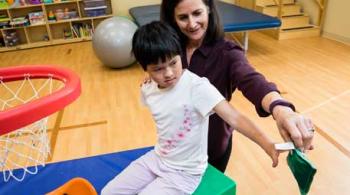12/6/16
By Kristie Sweeney, M.S.
Psychology Associate II
Kennedy Krieger Institute Concussion Clinic
What is a concussion?
The term concussion is frequently used interchangeably with terms such as mild traumatic brain injury (mTBI) and minor closed head injury. The Center for Disease Control (CDC) defines mTBI/concussion as “a bump, blow or jolt to the head or a penetrating head injury that disrupts the normal function of the brain,” including brief changes in mental status (i.e., disorientation, confusion, feeling out of it, etc.) and loss of consciousness immediately (less than 30 minutes) after injury (CDC, 2016). Many individuals who experience a concussion may also have difficulty remembering the injury and events that occurred immediately before and after the injury was sustained. This is referred to as post-traumatic amnesia (PTA). Neuroimaging is normal in an uncomplicated mild TBI, but when abnormal neuroimaging findings are observed, the injury is considered to be a complicated mild TBI or moderate TBI. Unfortunately, there is no scan or medical test that can diagnose a concussion; medical professionals use common signs and symptoms during the acute concussion period described above, as well as lingering symptoms (outlined below), to determine a concussion diagnosis.
Most brain injuries in children and adolescents are mild in nature and are considered concussions. Leading causes of concussions include sports, recreational activities, and falls. Therefore, school-age children are highly susceptible to concussions, suggesting that schools and teachers are a main component of the recovery process.
What are the signs and symptoms of a concussion?
The most important thing to remember is that every child is different when it comes to concussion! The number and severity of symptoms presented after a concussion is different for every child. Additionally, for children who sustain multiple concussions, each concussion may present itself differently. Symptom recovery time varies depending on the specific child and the specific occurrence. For the majority of children and adolescents, symptoms resolve within a few days, and almost all symptoms resolve within two to three weeks post-concussion; however, this is not always the case. For a small minority of individuals, symptoms last longer. Following a concussion, a child may experience any of the following symptoms (CDC, 2016):
Thinking and Remembering
- Difficulty thinking clearly
- Feeling slowed down
- Feeling sluggish, hazy, foggy, or groggy
- Difficulty concentrating
- Difficulty remembering new information
Physical
- Headache or “pressure” in head
- Nausea or vomiting
- Balance problems or dizziness
- Fatigue and feeling tired
- Blurry or double vision
- Sensitivity to light or noise
- Numbness or tingling
- Does not “feel right
Emotional and Mood
- Irritability
- Sadness
- More emotional than usual
- Nervous or anxious
Sleep Disturbance
- Drowsy
- Sleeps less than usual
- Sleeps more than usual
- Has trouble falling asleep
How is a concussion treated?
Research shows that following an appropriate treatment course, most children recover from a concussion quickly. There is little evidence to suggest permanent cognitive and behavioral deficits. Current literature supports a brief rest period (typically no more than two days) immediately following the injury, as well as a gradual return to cognitive and physical activity, rather than extreme, long-lasting restrictions. In fact, a group of well-respected physicians recently completed a research study which revealed that after concussion, a group of children who rested longer actually reported more daily post-concussive symptoms. The authors noted, “the deleterious effects of strict rest may have more to do with emotional distress caused by school and activity restriction” (Thomas et.al, 2015). That is, falling behind academically is a source of severe stress for many students, which can be complicated by confusion during school re-entry. Missing social or athletic events, isolation, and lack of exercise can lead to changes in mood, sleep and/or appetite, which in turn can exacerbate or maintain post-concussion symptoms. Thus, the most recent research does not support the idea of extended restrictive rest, as it is not clinically indicated, and may actually be more harmful. However, it is important to acknowledge that although many children and adolescents appear physically normal following a concussion, they often experience difficulties in the classroom and school setting. Therefore, it is important to approach the acute concussion period with a gradual return to cognitive activities and learning, which can be accomplished through basic and short-lived academic accommodations.
What can teachers and school professionals do to help aid students in recovery from concussion?
Immediately after a student is evaluated following a concussion, the school and parent(s) should create an environment of open communication. Teachers and schools should be informed of a student’s concussion as soon as possible in order to help students return to school and continue learning effectively and in the least amount of time possible. It is best if parent(s) can identify a point person in the school, such as a guidance counselor or nurse, who can communicate with parents closely over the transition period when a child is returning to school. The point person can assist in ensuring all teachers receive information regarding the student’s injury and academic accommodations during the recovery period. Additionally, the point person can provide parents and students with a list of missed assignments. As recovery progresses or new symptoms arise, the point person can help students and parents update academic plans and any accommodation changes.
Examples of school related accommodations following a concussion:
- Excusing all non-essential assignments
- Extended time to complete essential assignments and tests
- Minimizing the number of exams taken in one day as well as providing a quiet, distraction free environment during testing
- Reduced homework load
- Allow students to take rest breaks (10-15 minutes) as needed during the day in order to help reduce/minimize headaches. Breaks should be in a quiet location.
- Allowing the student to carry a water bottle and have snack breaks during the day in order to manage headaches
- Provide a copy of the lecture outlines and/or a copy of a peer’s notes during class
- Allow students to wear sunglasses during class or ear plugs during testing/completion of in-class assignments
- Brief restrictions from gym class and sports related activities
- Check in with teacher/nurse/guidance counselor throughout the week in order to monitor symptoms and school functioning
It is highly likely that most teachers will have a student who sustains a concussion during the academic school year. Therefore, it is critical that teachers and school professionals understand that signs and symptoms of a concussion as academic performance, behaviors, and school functioning can be impacted following a concussion. When schools and teachers understand concussions, the signs and symptoms post-injury, and recommended treatment approach, they can help students experience a less complicated and more rapid recovery process.
References:
Carroll, L.J., Cassidy, J.D., Peloso, P.M., Borg, J., von Holst, H., Holm, L., Paniak, C., Pepin. (2004). Prognosis for mild traumatic brain injury: Results of the WHO Collaborating Centre Task Force on Mild Traumatic Brain Injury. Journal of Rehabilitation Medicine, 36 (43 Suppl.), 84– 105. doi:10.1080/16501960410023859
Halstead, M.E., McAvoy, K., Devore, C.D., Carl, R., Lee, M., Logan, K., et al. (2013). Returning to learning following a concussion. Pediatrics, 132 (5), 948-957. doi:10.1542/peds.2013-2867
Thomas, D.G., Apps, J.N., Hoffman, R.G., McCrea, M., Hammeke, T. (2015). Benefits of strict rest after acute concussion: A randomized controlled trial. Pediatrics, 135 (2), 213-223. doi:10.1542/peds.2014-0966
Yeates K. (2010). Mild traumatic brain injury and postconcussive symptoms in children and adolescents. Journal of the International Neuropsychological Society, 16 (6), 953-960. doi:10.1017/S1355617710000986
(2016). Retrieved October 25, 2016, from http://www.cdc.gov/TraumaticBrainInjury/index.html















